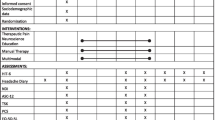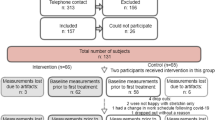Abstract
EMG biofeedback from the frontal area (FFB) was compared to EMG biofeedback from the neck (NFB) in the treatment of chronic muscle-contraction headache. Both treatment groups (N=10) evidenced significant decreases in reported headache activity, with the NFB group also significantly reducing medication consumption. An analysis of EMG changes suggested that subjects were able to produce large within-session changes in EMG activity during initial sessions, with the major effect of additional training being an increase in speed with which these changes occurred. In neither group, however, did changes in EMG activity correspond closely to changes in reported headache activity.
Similar content being viewed by others
References
Bakal, D. A., & Kaganov, J. A. Muscle contraction and migraine headache: A psychophysiological comparison.Headache 1977,17 208–214.
Basmajian, J. V. Facts vs. myths in EMG biofeedback.Biofeedback and Self-Regulation 1976,1 369–371.
Budzynski, T. H. Task Force Report of the Biofeedback Society of America: Biofeedback in the treatment of muscle-contraction (tension) headache.Biofeedback and Self-Regulation 1978,3 409–434.
Budzynski, T. H., Stoyva, J. M., & Adler, C. S. Feedback induced muscle relaxation: Application to tension headache.Journal of Behavioral Therapy and Experimental Psychiatry 1970,1 205–211.
Budzynski, T. H., Stoyva, J. M., Adler, C. S. & Mullaney, D. J. EMG biofeedback and tension headache: A controlled outcome study.Psychosomatic Medicine 1973,35 484–496.
Dixon, H., & Dickel, H. A. Tension headache.Northwest Medicine 1967,66 817–820.
Grant, D. A. Analysis of variance tests in the analysis and comparison of curves.Psychological Bulletin 1956,53 141–155.
Hays, W. L.Statistics for psychologists. New York: Holt, Rinehart & Winston, 1963.
Ostfeld, A. M.The common headache syndromes: Biochemistry, pathophysiology, therapy. Springfield, Illinois: Charles C Thomas, 1962.
Philips, C. Tension headaches: Theoretical problems.Behaviour Research and Therapy 1978,16 249–261.
Shealy, C. N. Task force study section report on pain. Prepared for the Biofeedback Society of America, August 1978.
Travell, J. Mechanical headache.Headache 1967,7 23–29.
Winer, B. J.Statistical principles in experimental design (2nd ed.). New York: McGraw-Hill, 1971.
Author information
Authors and Affiliations
Rights and permissions
About this article
Cite this article
Hart, J.D., Cichanski, K.A. A comparison of frontal EMG biofeedback and neck EMG biofeedback in the treatment of muscle-contraction headache. Biofeedback and Self-Regulation 6, 63–74 (1981). https://doi.org/10.1007/BF00998794
Received:
Issue Date:
DOI: https://doi.org/10.1007/BF00998794




